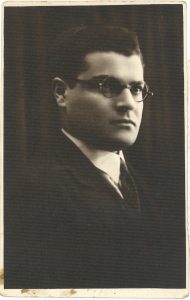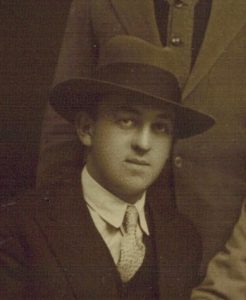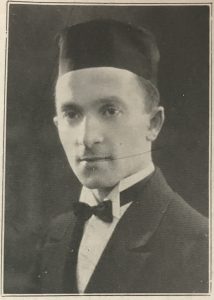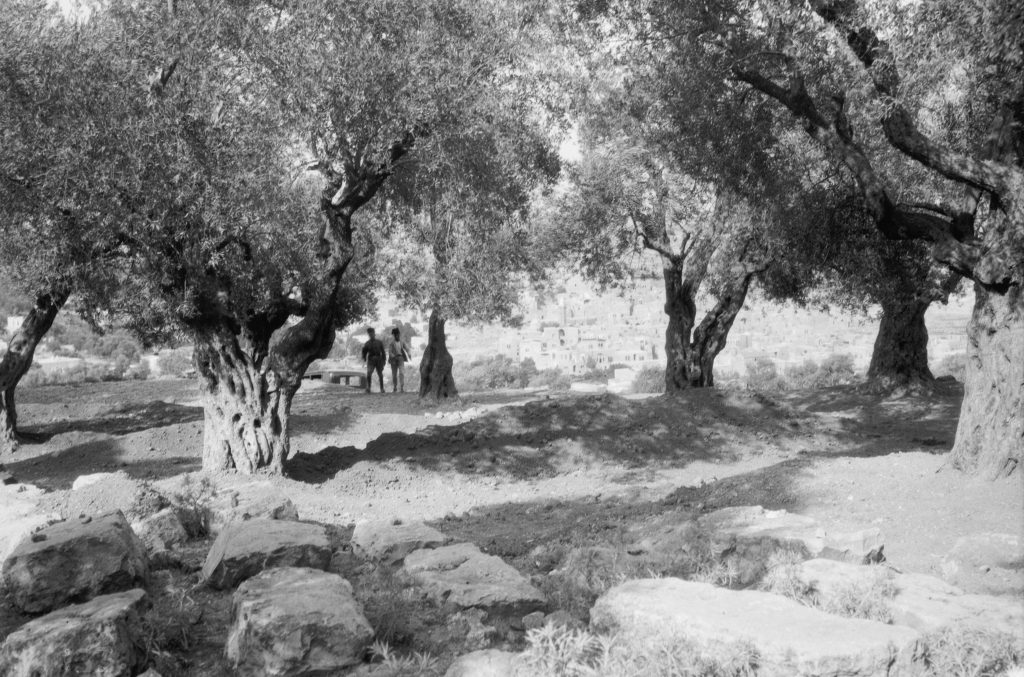
The communal gravesite dug in the shade of olive trees for the victims of the Hebron Massacre. Courtesy of the G. Eric and Edith Matson Photograph Collection/Library of Congress
August of 2019 marked the ninetieth anniversary of the 1929 Hebron Massacre that claimed sixty-seven lives. During the two days of rioting, which started on August 23, 1929, Arab mobs, armed with axes and knives, went from house to house in the “Jewish ghetto” in Hebron. Scores of Jews were maimed, in addition to the murdered. Of the victims, twenty-four were young yeshivah students.
In 1924, Yeshivas Knesses Yisrael, the famed Slabodka Yeshiva, known as the “mother of yeshivas,” had relocated to Hebron from the Lithuanian town of Slabodka. Founded by Rabbi Nosson Tzvi Finkel, one of the most important leaders of the Musar movement, the yeshivah attracted students from all over the world. By 1929 there were close to 200 students, making it the largest yeshivah in Eretz Yisrael at the time.
The Massacre in Hebron, which was then under British rule, brought the centuries-old Jewish presence in the city to an abrupt end. Below are accounts from survivors of the Massacre, as told by their descendants.
Rabbi Moshe Gold
(1912-1956)
By Bayla Sheva Brenner
Descended from a long line of talmidei chachamim, Rabbi Moshe Gold, a survivor of the Hebron Massacre, was one of the early students of Yeshiva Torah Vodaath. His father, Rabbi Zev, served as the rav of a shul in Williamsburg, New York, where Rabbi Binyamin Wilhelm (Rabbi Yisroel Belsky’s grandfather), the founder of Yeshiva Torah Vodaath, was a congregant. In those days, most of the Jewish immigrants in America were reticent about sending their children to yeshivah; it was considered “un-American.” Rabbi Zev had other ideas. He took his young son Moshe, then six years old, to visit all the Jewish homes in the neighborhood and announced, “My son is going to yeshivah. Your son is coming with him.” Along with Moshe, these students formed the original nucleus of Yeshiva Torah Vodaath.
In 1921, when Moshe turned nine, the family moved to Eretz Yisrael. When he was a teenager, a conversation with a group of bachurim who were attending the Hebron Yeshiva made a profound impression on him. He came home and told his father, “I want to go learn in Hebron.”
What follows are the words of Rabbi Chaim Gold, seventy-seven, a former rebbe at Manhattan Day School for over fifty years and the son of Rabbi Moshe Gold—as told to Bayla Sheva Brenner
On erev Shabbos, August 24, 1929, the talmidim in the Hebron Yeshiva knew that something was going on. Tensions were brewing; they heard the talk among the Arabs in the street. But no one could have envisioned how catastrophic it would be. Grand Mufti of Jerusalem Haj Amin al-Husseini had spread rumors that the Jews intended to conquer the Temple Mount and to desecrate or destroy the Al-Aqsa Mosque. The Arab population was riled up. Around the time of Kabbalas Shabbos, a pogrom began.
All night long, bloodthirsty Arabs ran through the streets in search of Jewish victims. My father and his roommates barricaded the doors and windows of the home in which they lived. At dawn things seemed to quiet down. My father wanted very much to check on his rebbe, Rabbi Moshe Mordechai Epstein1 and daven with him. (Whenever my father spoke about the years during which he was privileged to learn in Hebron, he talked of how he revered Rabbi Epstein, from whom he had received semichah at the tender age of seventeen; Rabbi Epstein didn’t give semichah easily. When Rabbi Epstein passed away, my father tore keriah.) Although the bachurim didn’t hear anything going on in the streets, they were afraid that this was a ploy and they warned my father not to go outside. My father, however, insisted on checking on his rebbe and left the house.
As it turned out, all the boys in the house where my father had been hiding were slaughtered. When an Arab attacked a rebbe, a young bachur threw himself onto his rebbe, crying out, “You gave me life!” The young man was killed while saving his rebbe’s life.
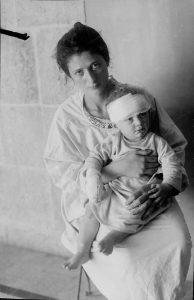
One-and-a-half-year-old Shlomo Slonim, the son of Eliezer Dan Slonim and sole survivor of his immediate family, photographed with his aunt. Photo: The Central Zionist Archives
My father reached the rosh yeshivah’s house. The Arabs pounded the door of Rabbi Epstein’s home with a battering ram. When the the battering ram broke through the door, it hit him in the face and knocked out one of his teeth. As this was happening, the British chief of police of Hebron rode past them, down the block. The rioters quickly dispersed. The yeshivah boys had pleaded with him on Friday afternoon to prevent the probable violence—however, he did nothing to stop it. The police chief’s wife even knew Rebbetzin Epstein. Prior to the Massacre, the Jews had very good relations with the Arabs in the area, and the yeshivah made sure everyone got along. [Eliezer Dan Slonim, one of the leaders of the Hebron Jewish community, was close friends with the local Arabs. Nevertheless, the Arabs slaughtered his entire family. Only his toddler son Shlomo survived.]
At some point, my father was wounded. His body was thrown together with a pile of corpses. Later, a reporter, trying to identify the murdered boys, searched their pockets for identification. He came across my father’s name and recorded it on a list of the murdered. My grandfather, who was traveling in Europe at the time, noticed someone reading a newspaper with a headline publicizing the terrible pogrom. He grabbed the newspaper and saw my father’s name listed among the murdered. It was then that my grandfather suffered his first heart attack—ultimately, he learned that my father had survived.
As bizarre as it sounds, the British actually detained and imprisoned the Hebron survivors. My great-uncle, my grandfather’s younger brother (Rabbi Dr. Henry Raphael Gold, who subsequently became the first frum psychiatrist in the US) was in Eretz Yisrael at the time. After Shabbos, when he heard what had transpired, he went to the American Consulate and prevailed upon the American officials to intervene and free his nephew. The Americans contacted the British officials in Hebron, who said they would try to release my father.
A short while later, they called to report a glitch: “The young man won’t leave unless all of the boys are let go, and we’re not going to do that.” My great-uncle then told the consulate, “Listen, that’s the American way. You stick up for your friends; you don’t abandon them! Are you going to penalize them for doing the American thing?!” The consulate got back on the phone insisting that the British release them all.
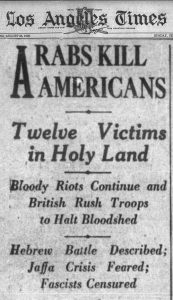
“Twelve Victims in Holy Land” cries a front page headline of the Los Angeles Times on August 26, 1929. Copyright © 1929. Los Angeles Times. Used with permission
Years later I showed a documentary film of the Hebron Massacre at Manhattan Day School, where I was teaching. The footage included a convoy of cars leaving Hebron to Yerushalayim with all of the survivors. I paused the film and told my students that it was because of my father that the convoy left for Yerushalayim.
The British governor of Palestine was a “menuval,” a disgrace. Later, after the Massacre, there was a meeting of certain dignitaries including the British governor. He was introduced to Rav Avraham Yitzchak HaCohen Kook and extended his hand. Rav Kook refused to shake his hand, saying, “They are hands covered with blood [of those murdered in Hebron].”
When I was learning in Eretz Yisrael many decades later, my father came to visit me. I had found the Sefer Zikaron that the Hebron Yeshiva had published for the first yahrtzeit in one of the bookcases in my grandfather’s house. It included a brief biography and photo of each boy who was murdered. I showed it to my father. As he went through page by page, he cried bitterly. He was almost speaking to the faces. He saw his chavrusa and his two roommates, all of them brutally murdered. That entire day he cried, reliving the experience.
After the Massacre, my father could no longer remain in Eretz Yisrael. He wanted to go learn in the Mirrer Yeshivah in Poland, even though my grandfather preferred that he return to America [the family had temporarily moved back to the US]. Dov Katz [later the author of a series of books on the Musar movement], who was a student of the Hebron Yeshiva, was engaged to my father’s sister. He survived because he was away visiting his kallah on the Shabbos of the pogrom. My father told Dov, “Don’t let my father know I went to Mir until I send a telegram that I’m settled in the yeshivah and I’m okay.” My father notified his future brother-in-law that he had arrived, but my grandfather was worried about him and traveled to Poland—a journey via ship that took several weeks.
When my grandfather arrived in Mir, he asked the mashgiach, Rabbi Yeruchem Levovitz, who was zealous about not letting the boys leave the yeshivah, for permission to take my father to the Chofetz Chaim for a berachah. Reb Yeruchem granted permission because of the trauma my father had experienced and the privilege of being blessed by that tzaddik. When the two of them arrived at the home of the great gadol in Radin, the gabbai told them that the Chofetz Chaim wasn’t feeling well and might not be up to seeing visitors. My grandfather told the gabbai that the young bachur with him was a survivor of the pogrom in Hebron. When the Chofetz Chaim heard that, he came out and grabbed hold of my father, hugging him and tearfully reciting a verse from Yeshayah HaNavi, “A feather plucked from the fire!” He then gave the young bachur a berachah. My father never forgot that meeting.
Notes
1. One of the leading talmidei chachamim of the twentieth century, Rabbi Moshe Mordechai Epstein (1866-1933) served as rosh yeshivahof Yeshivas Knesses Yisrael in Slabodka and in Hebron.
Bayla Sheva Brenner is an award-winning freelance writer and a regular contributor to Jewish Action.
Rabbi Dov Cohen
(1911-2005)
By Bayla Sheva Brenner
Rabbi Dov Cohen, who passed away at the age of ninety-four, was one of the Hebron Yeshiva students who survived the Massacre. His story is told in Vayelchu Shneihem Yachdav (in Hebrew, recently translated into English and titled To Rise Above–The Amazing Life of HaRav Dov Cohen zt”l: A Journey to Greatness Against All Odds [2017]).
In the winter of 1903, Zahava Golda Leah Cohen, a young mother of three, left her home in Lithuania with her children and boarded a steamship to America. Her husband, Reb Yehuda, had made the trip nearly three years before. His plan was to find work, save up enough money to support his family, and head back home. The long separation proved too much for his wife. The plans changed.
The family eventually settled in Seattle, Washington, where Reb Yehuda worked in a clothing store, rising from salesman to manager, and then opening his own successful establishment. Unfortunately, the “Land of Opportunity” offered little in the way of Jewish community or education. Most of their fellow Jewish immigrants opted for assimilation over Torah observance. Only a small number of Jewish immigrants clung to Yiddishkeit, and many of their offspring abandoned it altogether.
Mrs. Cohen lost many nights’ sleep watching her children embrace the secular life of the society around them. Descended from a line of erudite Torah scholars, she was not willing to leave to chance her dreams of her youngest son Dov becoming a ben Torah. In the summer of 1925, when Dov, known as “Benny,” was just thirteen years old, his mother took him on a long journey eastward across the United States, then across the Atlantic Ocean through the Strait of Gibraltar to Eretz Yisrael, the Holy Land.
At first Benny attended a religious high school in Tel Aviv, where he learned both secular and religious studies. But his Gemara teacher, Rav Yosef Ze’ev Lipowitz, suggested to his mother that they consider a fledgling yeshivah in Hebron, Yeshivas Knesses Yisrael, launched in 1924 by Rav Nosson Tzvi Finkel, the Alter of Slabodka. The yeshivah catered to advanced Torah scholars.
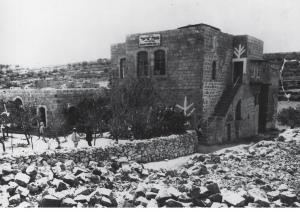
Yeshivas Knesses Yisrael in Hebron. Though many mistakenly think that the yeshivah building is the tall building bearing a sign with its name, in fact, the shorter, one-story building on the left is the yeshivah. The ground floor of the taller building served as the Beis HaMusar, a room designated for musar study, while the top floor was the Alter of Slabodka’s home. Courtesy of the Cohen family
Benny stepped into the yeshivah’s main room, which was filled with 200 bachurim learning musar. He picked up a sefer and watched. The musar seder ended, and Maariv began. He joined the chorus of voices.
He later wrote in his journal: “Suddenly, there was a moment’s silence; you could hear a pin drop . . . I literally jumped out of my seat from the thunderous noise. ‘Shema Yisrael, Hashem Elokeinu, Hashem Echad!’ The walls were trembling . . . I knew there would be no turning back . . . my decision was final. I was staying right here.”
And there, the boy from Seattle, one of the youngest bachurim in the yeshivah, exulted in the intensive learning and warm camaraderie—until the horrific tragedy that blew his world apart.
Benny was seventeen at the time of the Massacre—most of the talmidim were in their twenties. Since there were no dormitory facilities, he rented a room from an Arab. During the height of the Massacre, when the mob came to his home, the Arab landlord told the rioters that there were no Jews in his home. [There were courageous Arabs who saved Jews during the pogrom, as some of these stories attest.] He advised his young Jewish tenant to hide. And Benny’s life was spared.
Excerpt below from To Rise Above–The Amazing Life of HaRav Dov Cohen zt”l: A Journey to Greatness Against All Odds (Feldheim, 2017): 282-294
That Shabbos morning, I walked from my lodgings to the Lazarovsky home . . . Looking out my window, I watched as carloads of Arab sheikhs traveled toward Me’aras Hamachpelah, heading for the large mosque there. We davened Shacharis in the Lazarovsky home, too frightened to step outside. We read the Torah portion from a Chumash, as we did not have a Sefer Torah with us. By the time we reached Mussaf, everyone was terrified. We had a gut feeling that something terrible was about to take place.
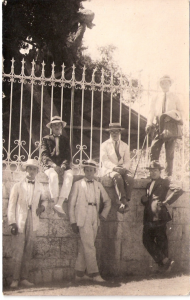
Rabbi Dov and his friends near the tree known as Eshel Avraham (the Tree of Avraham Avinu) in Hebron. Aside from Rabbi Dov, all the bachurim in the picture were murdered in the 1929 riots, Hy”d. Standing on the wall: Alter Sher. Sitting on the wall: Moshe Aharon Rifs (right) and Rabbi Dov (left). Standing on the ground, right to left: Yisrael Mordechai HaCohen Kaplan, Shlomo Yagel (son of Rabbi Shabsai Yagel, rosh yeshivah of Slonim) and Elchanan Zelig Ruch. Courtesy of the Cohen family
I could see the hill across the valley . . . Hordes of Arab peasants were trekking down the hill, heading straight for Hebron. There must have been hundreds of them, maybe even thousands. They spilled into the streets, singing war songs.
Mrs. Lazarovsky enjoined us to sit down and eat the Shabbos meal. But before she had even finished her sentence, bloodcurdling shouts pierced the air. Thousands of bloodthirsty Arabs began stampeding toward the Jewish homes.
We heard banging and more screaming . . . residents . . . ran outside, hoping to find shelter in the municipality’s nearby health clinic. Unfortunately, once outside they met up with the raged masses. . . As they ran back to the house, they tried catching the attention of the policemen who stood nearby, but the policemen didn’t move a muscle . . . Meanwhile, the rioters had filled the house. They pounced on the head of the family and killed him with their knives.
From our post on the top floor, we heard loud banging on the front gate . . . Had our turn come? The fear was tangible. Every person in the house shook uncontrollably . . . With superhuman strength . . . I hoisted a long, heavy bed on my back and placed it on the space between the front door and the inner steps leading up to the second floor, where we were all hiding . . . the Arab rioters refused to give up. They headed to the house next door; the Arab landlord lived in that house. They wanted to go up to his roof, jump onto our roof, and break into the house that way.
Without losing a moment, I jumped from our roof to the Arab landlord’s roof and began speaking convincingly, begging him not to acquiesce to their request. Using the little Arabic that I knew, I managed to communicate with him . . . He agreed not to let the mob into his house . . . His children, however, did not follow their father’s example. They screamed out to the mob, “There’s a Yahud here; there’s a Yahud here!”
I stood near the Arab’s window, trying to figure out what to do. The Arab mob noticed me and brought their hatchets down on the door …the Arab (landlord) assured me …“You’ve nothing to worry about.”
The argument between “my” Arab and the mob intensified . . . the landlord told me to find a hiding place. I looked around . . . One of the pits used for household needs in his home seemed to be an excellent hiding place. The opening led to a place that was something like a cellar. I moved aside the boards that covered the opening and crawled inside, replacing the boards after me.
Tensions were brewing; they heard the talk among the Arabs in the street. But no one could have envisioned how catastrophic it would be.
One of my friends had somehow managed to enter the Arab’s house as well. When he couldn’t find me, he began to worry. I removed some boards and told him to join me. Then another escapee arrived, and another. There were now four or five of us hiding in the pit.
The pit was a long, underground passage that ran under the street. We continued walking, the sounds of the crazed mob . . . right on top of us . . . We also heard ear-splitting shrieks and cries . . .
After waiting in the pit for a few hours, we realized that the storm had abated . . . We decided to leave our hiding place and return to the Lazarovskys’ home. There was not a living soul on the street. The Shabbos table was still set…
Mrs. Lazarovsky’s two sons had been murdered . . . one of their young daughters, Devorah, and his father in law, Reb Aryeh Leib Guttelevsky, were also murdered— three generations at once.
By Rabbi Dov Cohen’s son, Rabbi Tzvi Cohen, seventy-four, who lives in Bnei Brak—as told to Bayla Sheva Brenner
My father lived with Hebron constantly. In every aspect, he conducted every moment of his life according to the musar teachings of Hebron and Slabodka. It was as if he never left the Yeshiva. [He studied in the Yeshiva for three years before the pogrom and seven years afterward until he married.]
My father constantly lived with the miracle that saved his life. He wasn’t always eager to talk about surviving the Massacre, but if people (including his grandchildren) approached him wanting to hear the story so that they could pass it on to future generations, he would agree to tell it. At every family gathering, he would publicly thank Hakadosh Baruch Hu for saving him. He felt that Hashem was with him, as if he had seen the Shechinah. When he told the story of the pogrom, you felt you were there.
When the British evacuated the residents of the area after the pogrom, my father, because he spoke English, served as the translator between the British authorities and the Jewish community. Whatever wasn’t stolen or destroyed was collected and held by the British. The Hebron survivors worked together to contact the families of the victims and return their loved ones’ belongings.
While still a bachur at the yeshivah, my father was like a mashgiach. When the surviving bachurim came to the relocated yeshivah in Yerushalayim, he officially became an assistant to Rabbi Yehuda Leib Chasman, the mashgiach, spiritual mentor, of the Hebron Yeshiva. When Rav Chasman passed away, my father became the mashgiach.
Rav Kook refused to shake [the British governor’s] hand, saying, “They are hands covered with blood [of those murdered in Hebron].”
Over the years, my father kept in touch with the other survivors. Whenever they met one another, it was like a meeting of brothers. When my father took ill and needed a blood transfusion drawn directly from the body of a donor into his, one of his fellow Hebron survivors volunteered to do it. This achdus was part of the chinuch that had been ingrained in them with the Slabodka teachings, that every talmid was to be regarded as a brother, and to always seek to care for and help one another.
This was the primary message my father transmitted to our family: that we must work for the betterment of the Jewish people. Each of my siblings, in his or her own way, is involved in klal work—giving shiurim, writing sefarim, heading a beis din, providing premarital guidance.
Over the years, my father would take us to the site of the Massacre. Other Hebron survivors would accompany us. They would recount the history of each of the buildings and what happened during the attack in each place. We would visit the mass grave in Hebron.
I have in my possession the Shas my father used in the Hebron Yeshiva.
My father’s descendants wrote To Rise Above: A Journey to Greatness Against All Odds. More than a history book, it’s a book of musar, the story of how a young man so far away from home was able to rebuild after such a horrific tragedy. Before the State of Israel was founded, my father initiated an organization to launch shiurim in multiple neighborhoods. In the State’s early years, he served as rav of a shul in Yerushalayim. He went on to write sefarim and was appointed the first rabbi of the Israeli Air Force.
He used to cry for his rebbeim and comrades who were brutally murdered. He understood that the ways of Hashem are hidden. He surmised that Hashem saved him for a reason and made a commitment to dedicate the rest of his life to serving Klal Yisrael, learning Torah and performing mitzvos.
Rabbi David Winchester
(1898-1976)
By his grandson, Moshe Kaganoff, as told to Toby Klein Greenwald
Moshe Kaganoff was a young child when his grandfather died, but as the oldest grandchild he has special memories of his grandfather. His family and friends have filled in details over the years.
In 1929, when the Massacre took place, my grandfather, Rabbi David Winchester, was learning in the Hebron Yeshiva. He survived the Massacre and married in the late 1930s. He was relatively older by the time he and my grandmother had children—my uncle was born in 1939 and my mother in 1944.
He was a wonderful grandfather. He took me to many places, bought us gifts, and was very loving. Even though he died forty-three years ago, to this day there are many people who still remember him, including his former students.
My grandfather came to the Hebron Yeshiva as an older bachur. He was already a talmid chacham in nigleh and nistar [revealed and hidden aspects of the Torah], had semichah and was a rav in Springfield, Illinois. He was a very spiritual person who applied whatever he learned to himself. One year, while learning about the Churban and kedushat Eretz Yisrael, he was inspired to travel to Eretz Yisrael and learn in Hebron.
At one point, there was a very contagious typhus outbreak in the Yeshiva. It was decided to place the ill bachurim in quarantine; they were placed on the roof because the belief was that fresh air would be good for them. When the rosh yeshivah, Rabbi Moshe Mordechai Epstein, heard about this, he asked, “How do these bachurim eat?” The students told him, “Food is prepared for them, we knock on the door and leave the food there and the sick bachurim open the door and eat.” The rosh yeshivah replied, “That’s good for the bachurim who are well enough to get up, but what about those who can’t get out of bed?” No one had an answer. The rosh yeshivah went up to the roof to assess the situation and he discovered my grandfather there, feeding the boys who couldn’t get out of bed, despite the danger to himself. The next time my grandfather came to shiur, the rosh yeshivah stood up for him for the incredible chesed he was doing.
The Massacre in Hebron happened shortly after my grandfather arrived, perhaps within his first year there. I heard from Rabbi Yitzchak Sender of Chicago that during the pogrom, while the Arabs were stabbing Jews, my grandfather tried to save people. For his efforts, he was stabbed multiple times and left bleeding; he had many scars.
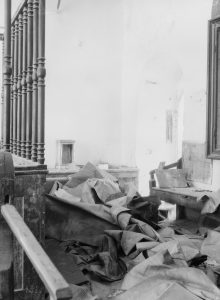
A large Torah scroll lies in a jumbled heap on the floor of a shul in Hebron desecrated by Arab rioters. Courtesy of the G. Eric and Edith Matson Photograph Collection/Library of Congress
Even a few Arab children participated in the Massacre. My grandfather told us that when he was on the roof after he was stabbed, he pushed his body against the floor in order to stop the bleeding, and he pretended he was dead so they would leave him alone. A little Arab child called out in Arabic, “The Yid is alive!” and they went back up to stab him again.
After nearly bleeding to death, he remained in Bikur Cholim Hospital for six months recuperating. He felt he was saved by God for a reason, that Hashem had put him on a mission to give, so he did boundless chesed for the rest of his life. He would give his coat away to someone who needed it. Everything he had he gave away. Chicago’s Hebrew Theological College, where he taught Gemara, began giving his paycheck directly to his wife so there would be food in the house. My grandfather lived just to give to others.
I remember one Pesach at home in the 1970s that was scary. At the Seder, my grandfather went into a trance and began describing the Massacre. He kept repeating the Arabic chant the attackers were yelling as they went from house to house looking for Jews. He was reliving it.
My grandfather was very frum. But he was a nistar. He didn’t have a beard, he dressed modern, didn’t wear his tzitzit out . . . He fasted every Monday and Thursday. He wanted to be known only as “Mr. Winchester,” not “Rabbi.” He was close to the Satmar Rebbe, Rabbi Yoel Teitelbaum, and when my grandfather passed away [the Satmar Rav said] he was one of the lamed vav tzaddikim. He was also close to the Lubavitcher Rebbe, Rabbi Menachem Mendel Schneerson.
He [Rabbi Winchester] felt he was saved by God for a reason, that Hashem had put him on a mission to give, so he did boundless chesed for the rest of his life.
In the 1930s my grandfather was very upset about the fact that there was a lack of observance of chalav Yisrael in America. He used to go to a farm to supervise the milking and bring home chalav Yisrael milk, which my grandmother would boil in order to pasteurize it. He would go to the prisons to make sure that prisoners had kosher food.
There were homeless people in my grandfather’s house; every “nebbech” in society was welcome. Our next-door neighbor [here in Israel] remembers that her father used to go to America to collect money and he would go to my grandfather. All my grandfather’s money went to others; he gave it all away and had tremendous debts. It is well known that he would secretly drop off money and Shabbos and yom tov food packages at people’s doorsteps and run away. Well before the existence of popular chesed organizations, he was a one-man chesed operation. In terms of his own behavior he was very frum, but he never imposed anything on anyone else. He treated other people only with chesed.
Toby Klein Greenwald, a regular contributor to Jewish Action, is a journalist, playwright, poet, teacher, and the artistic director of a number of theater companies. She is the recent recipient of the Lifetime Achievement award from Atara-The Association for Torah and the Arts for her “dedication and contributions in creative education, journalism, theatre and the performing arts worldwide.”
SIDEBAR A
Rabbi Menachem Krakowski on the Massacre
The maggid meisharim and moreh tzedek of Vilna, Rabbi Menachem Krakowski, delivered this sermon in the Great Synagogue of Vilna on the 23rd of Av, 1929, five days after the Massacre in Hebron (Arzei HaLevanon [Vilna, 1936], 117-118).
Translation by Rabbi Eliyahu Krakowski, great-grandson of the author
We are gathered within the ancient and holy walls of this synagogue, which remember the persecutions of the Jewish people, which remember too the years of Tach v’Tat [the Chmielnicki Massacres of 1648-1649]. We will restate what is stated in our Torah: “O nations, acclaim His people! For He will avenge the blood of His servants, wreak vengeance on His foes, and cleanse the land of His people” (Deut. 32:43) . . .
To speak of our new kedoshim [martyrs] . . . it would be impetuous on my part to claim to be able to understand their value; these are souls whose value cannot be understood so quickly.
Rather, this is what I must say to you: We read in this week’s Torah portion, “For you are a holy people unto the Lord your God.” We have had many kedoshim in our history, martyrs who sacrificed their lives for the sanctification of God’s name, for the covenant between Israel and our Father in Heaven . . . There have also been martyrs who sacrificed their lives for the sake of the Torah, for its study and for its honor, so that it should not be desecrated by those who have risen to desecrate it and those who carry its banner. Such martyrs we have had throughout our history, but kedoshim who sacrificed their lives for the sanctity of our Land, for the honor of our Land and for the sanctity of the Temple—such kedoshim we have not had for two thousand years, since the time that the oppressor robbed us of our Land and desecrated our Temple.
Our sages have taught us: “He who did not mention the Land [of Israel], the covenant, and the Torah did not fulfill his obligation” . . . We have had kedoshim for the sake of the covenant and for the Torah, but we were missing kedoshim for the Land. Now these youths have completed it. They gave their lives for the sanctity of the Western Wall, the remnant of our most precious place, and for the sanctity of the Land and its honor. After two thousand years, we have before us reincarnations of the heroes of yesteryear who fought till their last drop of blood on behalf of their Land.
SIDEBAR B
Excerpt from an article by Rabbi Yitzchok Hutner, a student at the Slabodka Yeshiva in Hebron, in memory of those who perished in the Massacre. In it, he notes the especially heavy casualties suffered by the American students, presumably because the attack took place after the yeshivah term had ended when most other students had returned home (Pachad Yitzchak: Iggerot uMichtavim, pp. 257-259). Rabbi Hutner studied in Yeshivas Knesses Yisrael both when it was located in Slabodka and after it moved to Hebron. His life was spared as he was away for the weekend. He was selected to edit the Sefer Zikaron for the martyrs of the yeshivah. Translation by Rabbi Eliyahu Krakowski
. . . A special place is occupied by the American contingent, who received a double portion of the cup of tragedy from which we drank at the end of 5689 [1929]. From the land of gold and silver they came to the City of the Patriarchs, in order to dedicate their best years to the formation of their characters. “What report did they hear so that they came?” A combination of two words: Slabodka-Hebron . . . They heard and they came, and they dedicated themselves with all their ability to the great task of improvement [aliyah], in order to return to their native land suffused with Torah and yirah, to bring light and warmth to their surroundings, to awaken the hearts of the young to follow in their path, with great dignity and great strength. More than once did it seem that with the smiles on their faces they must have recognized the bliss that would be their future life. So did they grow and flourish, blossom and bear fruit, on the fountains of Torah and yirah, flowers of grace, nobles of Israel in whom is our glory and our pride . . . And suddenly, in the middle of the sunshine of the day, the axe was waved, the feller had come up . . . There is no word in the mouth and no utterance on the tongue. “But, lo, O Lord, You know it altogether” (Psalms 139:4).
